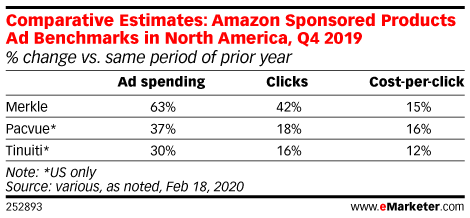Prices for Sponsored Product ads, Amazon’s most popular ad product, are continuing to go up according to a new report.
The report from eMarketer contains data from multiple firms that manage clients who buy Amazon ads.
Merkle reports that, among its clients in North America that have been spending on Amazon for at least a year, Q4 2019 spending on Sponsored Product ads was up 63%.
Data from Tinuiti shows that spending on Amazon sponsored product ads was up 30% among its clients during the same time period. The clients of Pacvue have seen similar increases as well.
The three companies – Merkle, Tinuiti, and Pacvue – reported 12% to 16% increases in the cost-per-click of Sponsored Product ads.

This is not a sudden increase, eMarketer notes:
“Prices on Sponsored Product ads have been rising for a while. In Q3 2019, Pacvue reported they were up 13%, while Merkle reported an increase of 11% and Tinuiti reported a 10% price jump.”
During the same time period, prices of Sponsored Brand ads have been falling. According to eMarketer, this is due to Amazon adding more inventory for the format in locations that are less likely to result in conversions. In other words, some of the placements are less valuable.
However, even with these declines, Sponsored Brand ads remain more expensive on a CPC basis than the average Sponsored Product ad.

eMarketer estimates that Sponsored Product and Sponsored Brand ads account for the bulk of Amazon’s ad business:
“These, and other primarily keyword-targeted search ads, will net Amazon $9.79 billion in US search ad revenues this year, up from just more than $7 billion in 2019.”
Source: eMarketer


